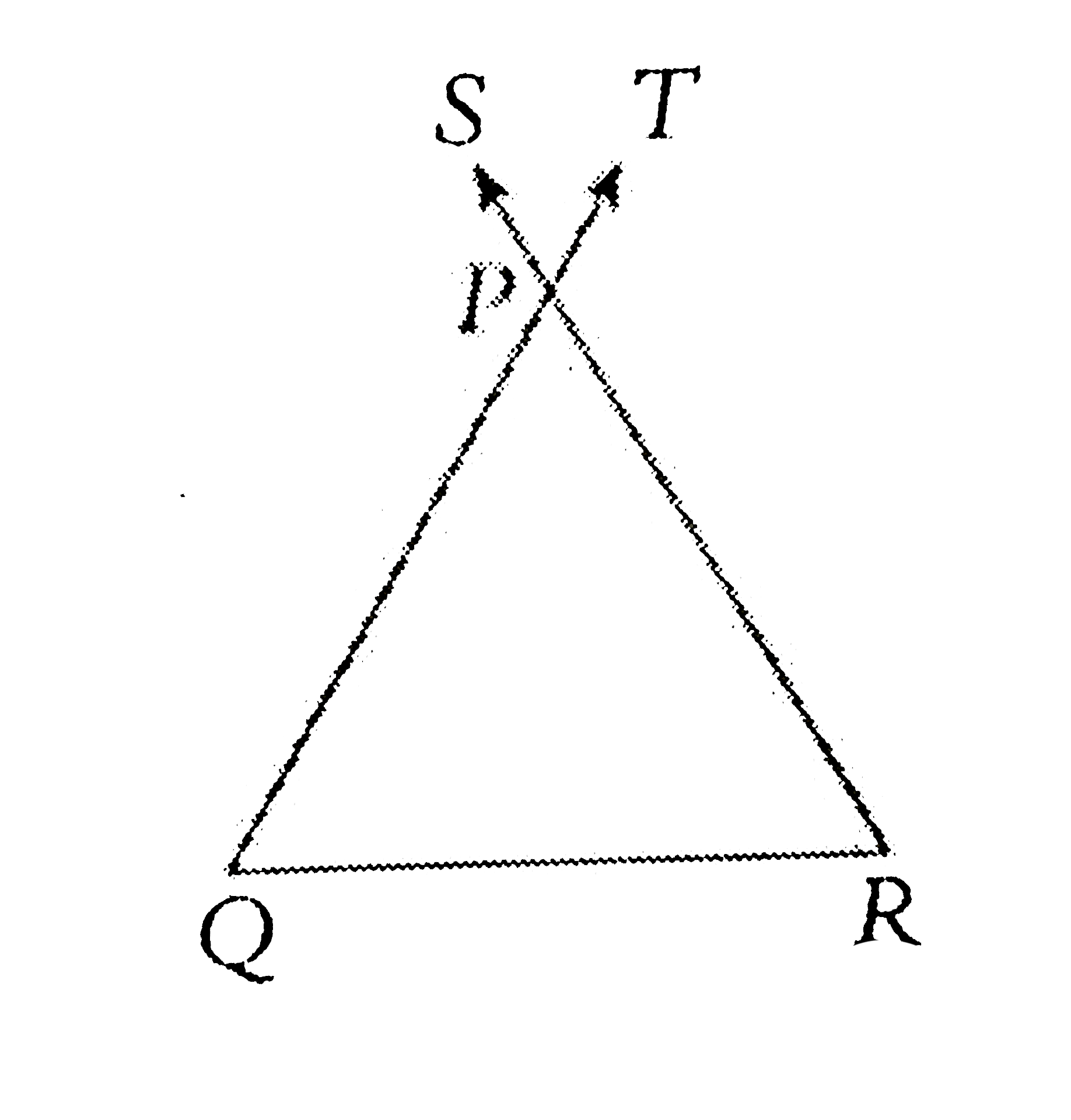In a △PQR,∠P=110∘, PQ = PR . Find ∠Qand∠R
The correct Answer is:∠Q=∠R=35∘
To solve the problem, we need to find the angles Q and R in triangle PQR, where angle P is given as 110 degrees and sides PQ and PR are equal.
1. Identify Given Information:
- Angle P = 110 degrees
- PQ = PR (which indicates that triangle PQR is isosceles)
2. Use the Isosceles Triangle Property:
- Since PQ = PR, the angles opposite these sides (angle Q and angle R) must be equal. Therefore, we can say:
Angle Q=Angle R
3. Apply the Angle Sum Property of a Triangle:
- The sum of the angles in any triangle is 180 degrees. Therefore, we can write:
Angle P+Angle Q+Angle R=180∘
- Substituting the known values:
110∘+Angle Q+Angle R=180∘
4. Substitute Angle Q for Angle R:
- Since Angle Q = Angle R, we can denote both as Q:
110∘+Q+Q=180∘
110∘+2Q=180∘
5. Solve for Q:
- Rearranging the equation gives:
2Q=180∘−110∘
2Q=70∘
- Dividing by 2:
Q=70∘2=35∘
6. Find Angle R:
- Since Angle Q = Angle R, we have:
Angle R=35∘
Final Answer:
- Angle Q = 35 degrees
- Angle R = 35 degrees
- Angle P = 110 degrees
- PQ = PR (which indicates that triangle PQR is isosceles)
- Since PQ = PR, the angles opposite these sides (angle Q and angle R) must be equal. Therefore, we can say:
Angle Q=Angle R
- The sum of the angles in any triangle is 180 degrees. Therefore, we can write:
Angle P+Angle Q+Angle R=180∘
- Substituting the known values:
110∘+Angle Q+Angle R=180∘
- Since Angle Q = Angle R, we can denote both as Q:
110∘+Q+Q=180∘
110∘+2Q=180∘
- Rearranging the equation gives:
2Q=180∘−110∘
2Q=70∘
- Dividing by 2:
Q=70∘2=35∘
- Since Angle Q = Angle R, we have:
Angle R=35∘
- Angle Q = 35 degrees
- Angle R = 35 degrees
Topper's Solved these Questions
- BOOK - CBSE COMPLEMENTARY MATERIALCHAPTER - TRIANGLESEXERCISE - PART-C12videos
TRIANGLES
- BOOK - CBSE COMPLEMENTARY MATERIALCHAPTER - TRIANGLESEXERCISE - PART-D15videos
TRIANGLES
- BOOK - CBSE COMPLEMENTARY MATERIALCHAPTER - TRIANGLESEXERCISE - PART-A (State which of the following statements are true and false )5videos
TRIANGLES
- BOOK - CBSE COMPLEMENTARY MATERIALCHAPTER - SURFACE AREAS AND VOLUMESEXERCISE - Practice Test8videos
SURFACE AREAS AND VOLUMES
Similar Questions
Knowledge Check
- Question 1 - Select One

In the figure above, ∠SPT=60∘and PQ=PR. Find ∠PQRA50∘B45∘C60∘D55∘ - Question 2 - Select One
In a triangle PQR,∠Q=90∘. If PQ=12cm and QR=5 cm, then what is the radius ( in cm ) of the circumcircle of the triangle ?
A5B6C6.5D6√2 - Question 3 - Select One
I is the incentre of a triangle PQR and ∠=107∘ then find the value ∠P.
A56°B34°C26°D42°
In a ΔPQR,∠Q=90∘,PQ=5,QR=12 find QM if M is centroid
View SolutionIn △PQR,PQ=10 cm , QR =12 , PR =8 cm . Find out the greatest and the smallest angle of the triangle .
View SolutionConstruct a triangle PQR in which PQ= 2cm. ∠P=45∘,and∠Q=105∘.
View SolutionIn △PQR ,∠Q=85∘ and ∠R=65∘. Points S and T are on the sides PQ and PR, respectively such that ∠STR=95∘, then the ratio of QR and ST is 9:5. If PQ=21.6 cm, then the length of PT is:
△PQRमें,angle Q= 85^@तथाangle R= 65^@है∣बिंदुSतथाTक्रमशःभुजाओंPQऔरPRपरइसतरहस्थितहैकिangle STR = 95^@ है | QR तथा ST का अनुपात 9 : 5 है | यदि PQ =21.6 सेमी है, तो PT की लंबाई ज्ञात करें |View SolutionIf in △PQR,∠P=120∘,PS⊥QR at S and PQ+QS=SR, then the measure of ∠Q is:
यदि त्रिभुज PQR में, ∠P=120∘, S पर PS⊥QR और PQ+QS=SR है, तो कोण Q का मान ज्ञात करें |View Solution

